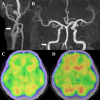A Sudden Unilateral Visual Field Loss in a Recreational Tennis Player: Cervical Internal Carotid Artery Dissection Associated With Low-Impact Sports
- PMID: 38813322
- PMCID: PMC11134497
- DOI: 10.7759/cureus.59305
A Sudden Unilateral Visual Field Loss in a Recreational Tennis Player: Cervical Internal Carotid Artery Dissection Associated With Low-Impact Sports
Abstract
Traumatic cervical internal carotid artery dissection (CICAD) is a rare condition caused by blunt trauma to the neck, often through automobile- or sports-related collisions, assaults, or falls. Herein, we report an unusual case in which engaging in a low-impact sport (tennis) caused CICAD, without a direct injury. A 56-year-old man with hypertension suddenly experienced a visual field loss in his right eye while playing tennis. Carotid echocardiography revealed severe stenosis of the right internal carotid artery (ICA). Angiography revealed severe and irregular stenosis of the right ICA from the bifurcation to the petrous portion, suggesting CICAD. Upon admission, the patient had left upper visual field defects in his right eye and neck pain. Antiplatelet therapy was initiated with prasugrel (3.75 mg/day), with the intent to treat surgically if the stenosis or symptoms progressed. Follow-up angiography and magnetic resonance imaging showed gradual resolution of the stenosis, and the patient was discharged on day 28 with a modified Rankin Scale score of 1. The CICAD should be considered as a diagnosis for neurological symptoms, even in the context of low-impact sports such as tennis. Antithrombotic therapy is a reasonable first-line treatment for stable CICAD.
Keywords: anticoagulants; antiplatelets; cervical arterial dissection; internal carotid artery dissection; low-impact sports; tennis.
Copyright © 2024, Yoshida et al.
Conflict of interest statement
The authors have declared that no competing interests exist.
Figures



Similar articles
-
Spontaneous Bilateral Cervical Internal Carotid Artery Dissection Treated with Simultaneous Bilateral Carotid Artery Stenting: A Case Report.NMC Case Rep J. 2019 May 25;6(3):71-74. doi: 10.2176/nmccrj.cr.2018-0257. eCollection 2019 Aug. NMC Case Rep J. 2019. PMID: 31417834 Free PMC article.
-
Isolated traumatic supraclinoid internal carotid artery dissection diagnosed by high-resolution vessel wall MRI.Br J Neurosurg. 2023 Dec;37(6):1801-1804. doi: 10.1080/02688697.2021.1919861. Epub 2021 Sep 29. Br J Neurosurg. 2023. PMID: 34585640
-
Bilateral carotid artery dissection due to Eagle syndrome in a patient with vascular Ehlers-Danlos syndrome: a case report.BMC Neurol. 2020 Jul 21;20(1):285. doi: 10.1186/s12883-020-01866-2. BMC Neurol. 2020. PMID: 32693780 Free PMC article.
-
[Spontaneous intracranial internal carotid artery dissection: 6 case reports and a review of 39 cases in the literature].Rinsho Shinkeigaku. 2003 Jun;43(6):313-21. Rinsho Shinkeigaku. 2003. PMID: 14503348 Review. Japanese.
-
[Spontaneous improvement of idiopathic intracranial carotid artery dissection: a case report].No Shinkei Geka. 2008 Jul;36(7):625-31. No Shinkei Geka. 2008. PMID: 18634405 Review. Japanese.
References
-
- Non-penetrating arterial trauma and cerebral infarction in the young. Hilton-Jones D, Warlow CP. Lancet. 1985;1:1435–1438. - PubMed
-
- Dissection of the extracranial vertebral artery after a tennis match (Article in French) Roualdes G, Lartigue C, Boudigue MD, Van der Marcq P, Drouineau J, Desplat A, Bataille B. https://pubmed.ncbi.nlm.nih.gov/2934716/ Presse Med. 1985;14:2108. - PubMed
-
- Ischemic cerebrovascular accident and sport activity. 6 cases (Article in French) Giroud M, Chague F, Guard O, Dumas R. Rev Med Interne. 1987;8:373–378. - PubMed
-
- Bilateral spontaneous dissection of extracranial vertebral arteries. Leys D, Lesoin F, Pruvo JP, Gozet G, Jomin M, Petit H. J Neurol. 1987;234:237–240. - PubMed
Publication types
LinkOut - more resources
Full Text Sources
Miscellaneous
